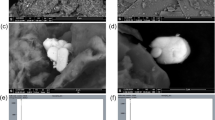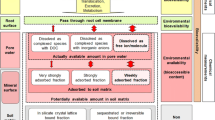Abstract
The radiotracer method has been used for investigation of the adsorption and desorption of traces of radium on ferric hydroxide and quartz under conditions similar to those prevailing in waste and surface waters. The effects of pH, liquid to solid ratio, ionic strength and presence of Ca2+ or SO 2-4 ions have been studied. It has been concluded that at pH less than 7 and at concentration of suspended sediments (of common composition) less than 100 mg·1−1 ferric hydroxide and quartz have negligible effect on the state and migration of radium in surface waters. Radium adsorbed on quartz can be easily desorbed with dilute solutions of hydrochloric acid or sodium chloride.
Similar content being viewed by others
References
P. BENEŠ, Physico-chemical Forms and Migration in Continental Waters of Radium from Uranium Mining and Milling. In: Environmental Migration of Long-lived RAdionuclides, IAEA, Vienna, 1982, p. 3–23.
E. C. TSIVOGLOU, J. Water Pollut. Control Fed., 35 (1963) 242.
E. HANSLÍK, A. MANSFELD, Final Report No. R-502004, Water Research Institute, Prague, 1973 (in Czech).
USEPA, Potential Health and Environmental Hazards of Uranium Mine Wastes, U.S. Environmental Protection Agency, Draft Report, Washington, 1979.
F. ŠEBESTA et al., Environ. Sci. Technol., 15 (1981) 71.
P. BENEŠ et al., Water Res., 17 (1983) 619.
E. A. JENNE, Trace Element Sorption by Sediments and Soils — Sites and Processes. In: Symposium on Molybdenum in the Environment, W. CHAPELL, K. PETERSON (Eds), Vol. 2, Marcel Dekker, New York, 1977, p. 425–553.
F. M. NELSEN, F. T. EGGERTSEN, Anal. Chem., 30 (1958) 1387.
F. ŠEBESTA, J. STARÝ, J. Radioanal. Chem., 21 (1974) 151.
P. BENEŠ, M. OBDRŽÁLEK, M. ČEJCHANOVÁ, Radiochem. Radioanal. Letters, 50 (1982) 227.
P. BENEŠ, V. MAJER, Trace Chemistry of Aqueous Solutions, Academia-Elsevier, Prague-Amsterdam, 1980.
P. SKŘIVAN, J. CHÁB, Acta Univ. Caroliane — Geologica, 4 (1975) 311.
A. MANSFELD, Ph. D. Thesis, Institute of Chemical Technology Prague, 1977 (in Czech).
A. MANSFELD, E. HANSLÍK, Final Report No. C16-331-112-03-04, Water Research Institute, Prague, 1980 (in Czech).
Author information
Authors and Affiliations
Rights and permissions
About this article
Cite this article
Beneš, P., Strejc, P. & Lukavec, Z. Interaction of radium with freshwater sediments and their mineral components. I.. Journal of Radioanalytical and Nuclear Chemistry, Articles 82, 275–285 (1984). https://doi.org/10.1007/BF02037050
Received:
Issue Date:
DOI: https://doi.org/10.1007/BF02037050




